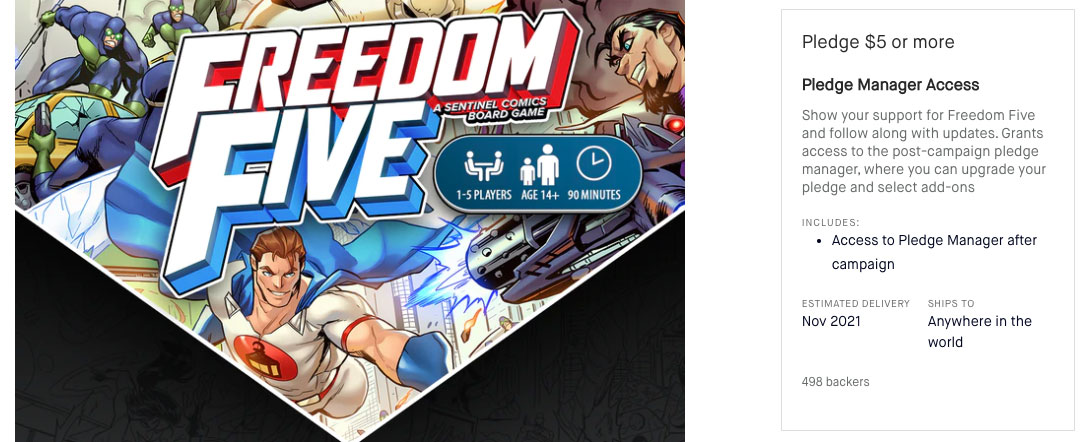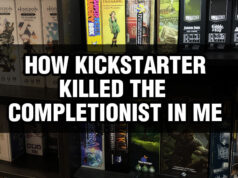How many of you have backed a Kickstarter project before? Show of hands? Yes, about all of you, that’s what I’ve figured. Now how many of you have Kickstarter regrets where you backed a game that ended up being a clunker, something you promptly got rid of? Hrm, yup, that’s about the same amount of hands.
I’ve backed a lot of Kickstarter projects over the years… way more than I probably should have. I’m a bit scared to go check my success rate on how many games I still actually own, but I’m guessing it’s 40% or less. So because of that, I’ve started being a little bit more conservative with the projects I back. And one way I do that is by being a $1 backer. Wait? That’s a thing you say? Indeed it is and it’s good for just about everyone!
All Kickstarter campaigns have pledge levels that get you products. That’s the whole reason to give these companies your hard-earned money—to get a game that you’ll eventually be able to play. Yet, over time, I’ve noticed a growing trend. More and more people are pledging $1 instead of opting for a full pledge level. I’m sure there are a lot of reasons for this. Maybe they just want to support the project but don’t actually want the game—call it a tip for the creator. But maybe not.

The big reason, at least for me, is to delay the decision of if I actually want to buy this game. One thing Kickstarter campaigns are good at is generating hype—it’s new and shiny. There are a lot of flashy graphics, live playthroughs, quotes from board game media sites, new reveals… you name it. It can be really easy to see a good looking campaign, think “I want that” and click the pledge button. Perhaps that’s why a majority of a project’s funding comes within the first 48 hours. Everything is so new and exciting. So how do you make sure you aren’t letting the excitement of a new game affect your purchasing decision?
By being a $1 backer. It gives you access to the campaign, so you can still comment on the project and get updates, yet it doesn’t actually commit you to pay $50, $100, or even more. There are a handful of projects I’ve backed in the last year at $1 where I’ve waited until the last minute (when the pledge master is about to close) to decide If I want to go all-in (or even partially). By this time, the excitement has worn off, other games have come to light to fight for my gaming dollar, and I can take a serious look if I still even want this game. Sometimes, it’s yes and I upgrade to a full pledge. About an equal amount of times (or more), it’s naw, I don’t really need this and I just let that $1 fad into oblivion.
It also helps combat Fear of Missing Out (FOMO) because it gives you a massive amount of time to make a decision. Most Kickstarters are 2-3 weeks, at most. As the daily reveals keep popping and more and more plastic gets added to the box, it can be hard to resist. You might be dancing around like Homer Simpson waiting to get to the chili cookoff. So pledge for that $1 and come back 6 months later and take a fresh look at everything. Ask yourself, “Does this game still look fun?” And as an added bonus, the game should be deeper into the production cycle so you can usually get a better look at final components, rules, and gameplay.

So yes, $1 backing can be really good for backers. But what about project creators. Once a game funds, $1 backers aren’t going to help get you those tasty stretch goals, right? Well, I got news for your partner: many of those stretch goals are just a pure marketing gimmick made to drive hype and get you to talk about their campaign. While they may look like the proverbial carrot dangling in front of the donkey, they are most likely going to be in the game either way. If you see a campaign with stretch goals announced, but not the dollar amount (past the active one) then you’ve found the marketing stretch goal. Creators do that because if the campaign stalls, they can change the funding amount for the stretch goal on the fly. While, yes, there are some legitimate stretch goals based on economies of scale, those are far from the norm in my experience. That’s why many campaigns have now moved to “daily reveals” or other such things. They’ve basically dumped the façade of them being tied to a funding level.

So now that we’ve pulled back the curtain on stretch goals are $1 backers still good for creators or just freeloaders? Of course they are. While they have the downside of making the campaign look less successful than it is, there is still an upside. Kickstarter takes about an 8% or so cut of a campaign’s funding (IIRC). A $1 backer gives a much smaller cut to Kickstarter than a $100 backer. So that $99 you give them in the pledge manager? The creator gets a MUCH bigger slice of the pie. It’s win-win, right?
In my opinion, yes. But it appears that not every creator feels that way. $5 pledge levels have started to creep up into more campaigns. These don’t get you the game, but offer “access to the pledge manager”. Why are they doing this? I’m not completely sure, but if I had to speculate, $5 is a bigger commitment than $1. One dollar is an amount you are comfortable losing in the cushions of your couch, while five dollars is a meal at Wendy’s. My guess is that they are trying to get a slightly bigger financial investment to make you much more apprehensive about abandoning your pledge—it helps build a bigger emotional attachment. Not only do they get a bigger cut of the pledge in the pledge manager, but probably less drop-off of those low-level backers.

So there you have it. Once a project funds, I pretty much don’t back for anything higher than a buck anymore unless it’s a game I know I really want. I’ve lost maybe $3-$4 doing this, but saved much more in games I probably shouldn’t have backed anyway.





















A very sensible approach. I’ve looked at many Kickstarter games but never went ahead with the pledge. As you say, I changed my mind after consideration
I’ve got a similar system, but bookmark a campaign instead. So my “fish or cut bait” convo with myself is after it’s clear which stretch goals have been hit, but obviously before the KS has closed.
I still get the cooling off period for projects I’m on the fence about, and an added benefit is that I don’t have to deal with early bird discounts, which force a decision—and financial commitment—much earlier in the campaign.
Then again, I’ve still backed fewer than 50 projects, and have only been dissatisfied with one so far.
I’ve done this for a while – sometimes just for games that are interesting, but way more than I can justify. Sometimes for a game I want to think about a bit. Sometimes I convert to something larger prior to the end of the campaign. A lot of times I don’t. I do wish KS had a way to mark those $1 “no reward” pledges as “received” so they could filter off the list of non-received projects. 🙂